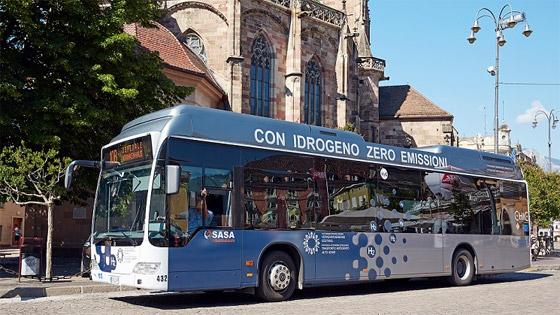
Trials in cities around the world have demonstrated that fuel-cell passenger buses can cut emissions and noise pollution while providing good quality public transport. New EU-funded projects could double Europe's fleet of hydrogen buses - reducing vehicle and infrastructure costs per bus to boost take-up of the technology.
Fuel-cell buses are an attractive solution for public transport – they can travel long, cost-effective shifts before being refueled quickly at bus depots, yet are quiet and produce no carbon or particulate emissions, minimising their environmental and health impacts.
The buses are powered by electro-chemical cells that combine hydrogen stored in high pressure tanks with oxygen from the air to generate electricity, heat and water. Performance compares well to the more established diesel, trolley (tram) and battery bus technologies.
According to trials, there is no perceptible difference: hydrogen buses are clean, smooth and easy to drive. A fuel cell bus can drive for 300-450 kilometres before it needs to be refueled, says the FCH JU bus study. This gives the technology an edge over most established battery buses, which have more limited ranges. And as they carry enough fuel on board for a full shift, the buses need very little route infrastructure, unlike trolley buses and some battery buses.
Breaking barriers
In the last 15 years, fuel cell buses have improved greatly. Hydrogen fuel efficiency has increased threefold to around 8-9 kg H2/100 km, while refuelling times have more than halved to under 10 minutes. However, only 91 fuel cell buses are operating in Europe.
Why aren’t they used more widely? Part of the reason is that they are still a young technology. Bus fleet operators are reluctant to invest in the new vehicles without concrete evidence of the risks and returns involved, while low demand makes them expensive to build and limits post-sales support.
To address these barriers, small-scale demonstration trials of fuel cell buses have been taking place in commercial fleets around the world. These provide data on costs and good operational practice, improve economies of scale and supply chains, give operators a say on how to develop bus models, and raise public awareness of the technology.
Key trials based in Europe include:
- CUTE. The first EU-funded trial, having started in 2003. It tested fleets of three buses in nine European cities over three years.
- This project extended small-fleet demonstrations to 10 cities on three continents, funding a total of 47 buses.
- High V.LO-City, HyTRANSIT and 3Emotion. These FCH JU-funded projects are trialing bigger fleets of around 20 buses in more cities.
These demonstration projects have been successful with operators and passengers alike. For example, as part of CHIC, a small fleet of eight fuel cell buses in London (UK) has operated along a busy route popular with tourists. It has performed so well that the participating transport company now intends to expand its hydrogen fleet.
Capacity-building
The FCH JU now supports 67 of the buses in Europe. It has published a call for proposals for a trial of at least 100 buses. Should this demonstration be successful, it will increase confidence in investing in fuel cell bus fleets. He adds that existing interest from bus operators could expand Europe’s fleet to over 500 buses, with a potential European market worth €1.5 billion.
Fuel cell buses could catch up to battery bus production and technical levels in 5-10 years.
The FCH JU played a pivotal role in bringing the demand and supply sides together, helping Europe become a world leader in the technology.
These efforts could be the first step in developing a fully competitive market using hydrogen-based zero-emissions urban transpor. The implications are enormous in terms of the environment, job creation and economic development.
Read the entire article here
Details
- Publication date
- 13 September 2016
